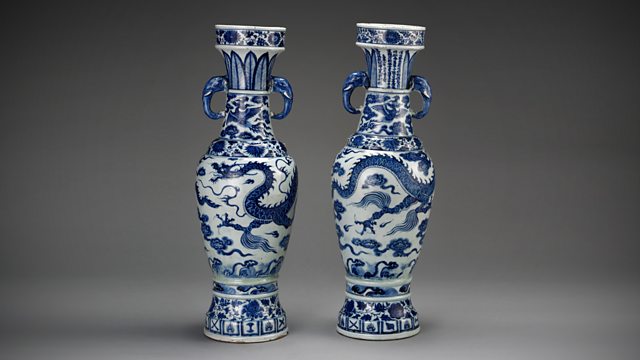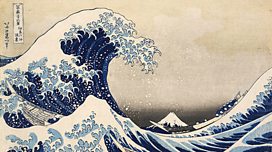The David Vases
Human history as told through things left behind. Today, Neil MacGregor is with a pair of blue-and-white porcelain vases from Yuan dynasty China.
The history of the world as told through objects that time has left behind. This week Neil MacGregor, the director of the British Museum, has chosen some of the great status symbols of the world around 700 years ago - objects with quite surprising links across the globe. Today he is with a pair of porcelain vases from Yuan dynasty China. This instantly recognisable blue-and-white designed porcelain - that we usually associate with the Ming Dynasty - rapidly became influential and desirable around the world. Neil describes the history of porcelain and the use of these vases in a temple setting. The historian Craig Clunas talks about the volatile world of Yuan China while the writer Jenny Uglow tries to put her finger on just why we find Chinese porcelain so appealing.
Producer: Anthony Denselow
Last on
![]()
Discover more programmes from A History of the World in 100 Objects about art.
About this object
Location: China
Culture: Ancient and Imperial China
Period: 1351
Material: Ceramic
��
The David Vases are the best-known porcelain vases in the world because of the rare inscriptions around their necks, dating them to precisely AD 1351. When first discovered they were believed to be the oldest dated example of blue-and-white porcelain in the world. They are named after their most famous owner, Sir Percival David (1892-1964), who built-up one of the world's greatest Chinese ceramic collections. They were originally altar vases, commissioned by a man called Zhang Wenjin, and presented as an offering to a Daoist temple.
Who created the first blue-and-white porcelain?
The David Vases were made during the reign of the foreign Yuan dynasty (1279-1368), when China was at the heart of a vast Mongol Empire. Trade flourished between China and the Middle East and cobalt, used to create the blue effect, came from the other side of the empire in Iran. Archaeologists have unearthed materials which now show that Yuan dynasty blue-and-white porcelain was made for several different markets, rather than solely for export as was once thought. Different consumers demanded specific forms, sizes and designs.
Did you know?
- Porcelain that is fired without glazing is known as bisque, or biscuit-fired.
Like a wonderful language
By Jenny Uglow, biographer, critic and publisher
��
What I love is actually the early history. The blue dye, the cobalt, came originally from Iran, or Persia: Persian blue. So you have a wonderful sort of Persian and Turkish Iznik pottery which is very free and splendid, and then the Chinese bought it and were thrilled, in about the ninth and tenth century, and developed it to perfection by the twelfth and thirteenth century. And they of course adapt it for their shrines with the dragons and the sacred symbols.
Then it comes to Europe and the Dutch adapt it to their life, and so it comes to Britain and we adapt it to the forms of jugs we like, the plates we love, and so on. So it retained this sort of status and then it has become a tradition, and then it became adapted again so you get these strange mixes in the eighteenth century; you get wonderful sort of Chinese landscapes with pagodas and willows, and perfectly ordinary English couples walking among them. It becomes translated, it’s like a wonderful language which is perpetually translated to the culture where it’s arriving and is loved.
I think the fascinating thing about these vases is that they are so beautiful and mysterious with that curling dragon and their elephant handles, and yet they seem tremendously familiar; they seem like an object you have known all your life simply because they have had this great legacy, as it were, of repetition and reflection down through the centuries.
Vigorous and powerful porcelain
By Craig Clunas, Professor of the History of Art, University of Oxford
��
These vases are in the shape of metal objects; the shape that they are in would have originally been made in bronze rather than in ceramic, and of course it’s possible that people looking at them saw them as an inferior substitute for bronze which was almost certainly a more expensive and lavish metal. So in a way you’ve got decorative exuberance here substituting for preciousness of material, so I think its quite possible that seeing these on an altar piece with a very prominent inscription – the man who paid for them made sure that we know what his name was and how he paid for them – some people may have thought ‘gee this is amazing’ but some people may have thought, you know, this is a bit flash – this is a bit vulgar.
To specialists in the field they are enormously famous and revered. I don’t think they are the most beautiful pieces of porcelain – they’re vigorous and they’re powerful. I think Zhang Wenjin, the man who paid for them, got value for money because they stand up and they say ‘look at us’, we’re rather big and splendid and therefore the man who paid for us must be important too.
I don’t think they fit into the modern domestic interior, and they’re certainly not the most beautiful pieces of Yuan porcelain, but they will always be important, they’ll always be significant, and I think there will always be more questions to ask about them.
The most famous porcelains in the world
By Jessica Harrison-Hall, curator, British Museum
��
The David Vases are the most famous porcelains in the world. Looking at them makes me think about the ubiquitous nature of blue-and-white ceramics, about the importance of the discovery of porcelain and what an amazing impact it has had across the globe. I can imagine the time when they were made and what China must have been like towards the end of the Yuan dynasty. Finally my thoughts turn to the decipherment and interpretation of the texts around their necks.
Potters fired white porcelain in China from about 600 AD. Merchants from the Middle-East introduced blue-and-white designs to China in the Tang dynasty (AD 618-906) and they were quickly copied and exported back using finer materials. It was not until about the 1320s that China became a centre for blue-and-white porcelain production.
Jingdezhen, where these vases were made, is one of the most important industrial centres in global history. Factory workers made these vases for an altar in a Daoist temple in China, but at the same time many of their colleagues were firing blue-and-white wares for export to the Middle East, Southeast Asia and Africa.
Without the invention and circulation of Chinese blue-and-white porcelain our homes would look quite different. Before Portuguese, Dutch and English traders shipped vast quantities of porcelains to Europe in the sixteenth to eighteenth centuries table wares were far rougher.
The arrival of porcelain in the West brought about a transformation in dining and in European ceramic production.
Transcript
Broadcasts
- Thu 1 Jul 2010 09:45������̳ Radio 4 FM
- Thu 1 Jul 2010 19:45������̳ Radio 4
- Fri 2 Jul 2010 00:30������̳ Radio 4
- Thu 8 Jul 2021 13:45������̳ Radio 4 FM
Featured in...
![]()
Art—A History of the World in 100 Objects
A History of the World in 100 Objects - objects related to Art.
Podcast
-
![]()
A History of the World in 100 Objects
Director of the British Museum, Neil MacGregor, retells humanity's history through objects





